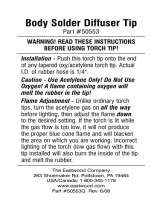10
Portable Oxy-Fuel Welding and Cutting Outfit
www.chpower.com
Limited 5-3-2 Warranty
1. Duration: The manufacturer warrants that it will repair, at no charge for parts or labor, the Torch, Regulators, or Hose, proven defective
in material or workmanship, during the following time period(s) after date of original retail purchase:
For 5 Years: The Torch and Cutting Attachment
For 3 Years: Regulators
For 2 Years: Hose, Welding Tips, Heating Attachments
2. Who Gives This Warranty (Warrantor):
Campbell Hausfeld
A Scott Fetzer Company
100 Production Drive
Harrison, OH 45030
Telephone: (513)-367-4811
3. Who Receives This Warranty (Purchaser): The original purchaser of the Campbell Hausfeld product.
4. What is covered under this warranty: Defects in material and workmanship which occur within the duration of the warranty period.
5. What is not covered under this warranty:
A. Implied warranties, including those of merchantability and FITNESS FOR A PARTICULAR PURPOSE ARE LIMITED IN DURATION TO THIS
EXPRESS WARRANTY. After this period, all risks of loss, from whatever reason, shall be on the purchaser. Some states do not allow
limitations on how long an implied warranty lasts, so above limitations may not apply to you.
B. ANY INCIDENTAL, INDIRECT, OR CONSEQUENTIAL LOSS, DAMAGE, OR EXPENSE THAT MAY RESULT FROM ANY DEFECT FAILURE OR
MALFUNCTION OF THE CAMPBELL HAUSFELD PRODUCT. Some states do not allow limitations on how long an implied warranty lasts,
so above limitations may not apply to you.
C. Any failure that results from accident, purchaser’s abuse, neglect or failure to operate products in accordance with instructions
provided in the owner’s manual(s) supplied with the product.
D. Pre-delivery service, i.e. assembly and adjustment.
7. Responsibilities of Warrantor under this warranty: Repair or replace, at Warrantor’s option, products or components which have
failed within duration of the warranty period.
8. Responsibilities of purchaser under this warranty:
A. Deliver or ship the Campbell Hausfeld product or component to Campbell Hausfeld. Freight costs, if any, must be borne by the
purchaser.
B. Use reasonable care in the operation and maintenance of the products as described in the owner’s manual(s).
9. When Warrantor will perform repair or replacement under this warranty: Repair or replacement will be scheduled and serviced
according to the normal work flow at the servicing location, and depending on the availability of replacement parts.
This Limited Warranty gives you specific legal rights and you may also have other rights which vary from state to state.
Symptom Possible Cause(s) Corrective Action
1. Tip is too large
2. Tip too close to work
Dirty tip
1. Tip loose
2. Seat is nicked
1. Oxygen needle valve on torch
handle partially closed
2. Oxygen cylinder depleted
Flashback
Backfire
1. Use next smaller size tip
2. Raise tip slightly farther from work
Clean with tip cleaner or replace the tip
1. Tighten tip nut
2. Replace tip
1. Open oxygen valve completely
2. Replace empty cylinder with full cylinder
Immediately turn torch off. Consult Operation section
See Operation section
Welding Tip Popping
Flames are not clearly
defined
Cutting tip popping
Flame changes during
cutting operations
Flame burns with shrill or
hissing noise
Flame goes out with a
loud pop
Troubleshooting Chart










